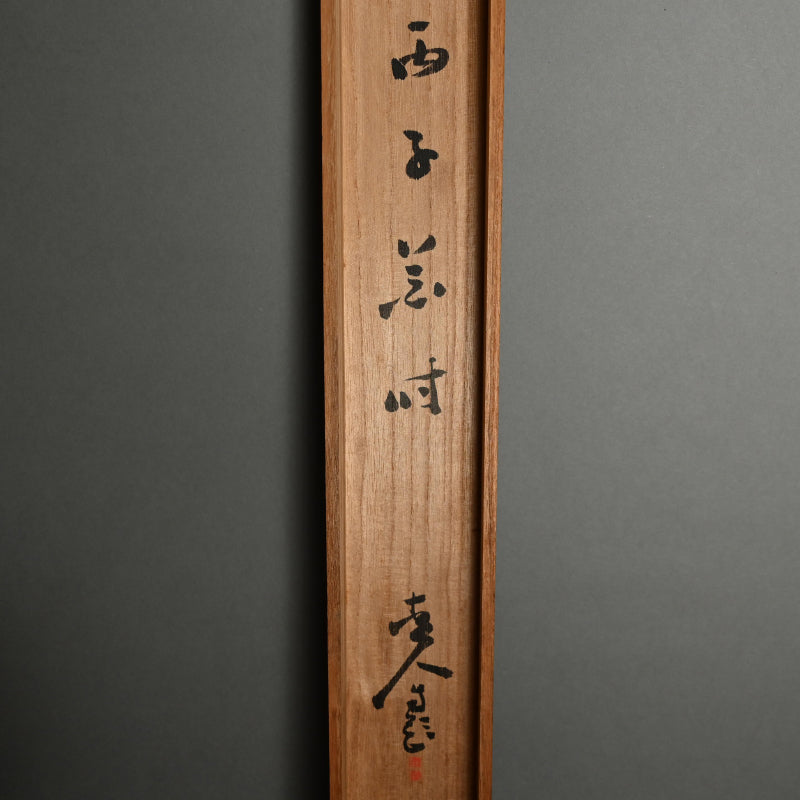Night in the Bamboo Grove, 1920 ー福田 古道人 “竹林山水圖”
Night in the Bamboo Grove, 1920 ー福田 古道人 “竹林山水圖”
Item Code: 古10
Couldn't load pickup availability
Rendered in an exquisitely restrained monochrome palette, this hanging scroll by literati genius Fukuda Kodojin evokes the quiet shimmer of moonlight filtering through a stand of bamboo. Kodojin situates the viewer at the threshold of a secluded scene, a dwelling, half-hidden among swaying stalks and drifting mist, where the presence of human life recedes into near-emptiness. The moon—reduced to a single luminous disc—anchors the composition as a point of stillness amid gently shifting washes of ink. The bamboo, articulated with both swift calligraphic strokes and soft modulations of tone, becomes a vehicle for the painter’s own contemplative interiority. Dated the 3rd month of 1920, it is performed with ink on silk in coffee colored patterned silk with black lacquered wooden rollers. The scroll is 52.5 x 176 cm (21 x 69-1/4 inches) and in fine condition, with some minor marks and toning typical of age. It comes enclosed in a signed wooden box titled Chikurin Sanzui-Zu.
A possible translation of the poem is:
Seated alone within the dark bamboo grove,
the bright moon bathes the cool forest in light.
This evening feels timeless — as if the ages themselves were present —
and the high, clear autumn air brings ease to the heart.
Turning my thoughts toward the noble ones I admire,
I need no more than the quiet resonance of a zither’s strings.
Though the melodies of youth have faded,
the music of mountains and flowing water remains enough.
Fukuda Kodojin (1865-1944) was an eccentric self taught artist, his status as a poet, calligrapher and literati artist has reached legendary status. Born at a time of great change (4 years before the final fall of the Edo Government), he lived through the westernization of Meiji, Taisho Democracy, the rise of Imperialism and final defeat of the Showa eras. He was part of a small group of artists existing outside conventional circles in pre-war Japan. He moved to a village outside of Kyoto in 1901, where he supported himself and his family by privately tutoring those who wished to learn Chinese-style poetry. Kodojin was simply a scholar. His poetry, painting, and calligraphy all stem from a life-long cultivation of the mind. He was said to have taken the time just before his death to destroy the large portion of his own remaining work, leaving only that which must have met some personal criteria. Kodōjin’s paintings and calligraphy survive mainly in private collections, but significant works can be found in the collections of the British Museum, Freer Sackler Gallery of the Smithsonian Institute, Honolulu Museum of Art, Houston Museum of Fine Arts, Kumamoto Prefectural Museum of Art, Minneapolis Institute of Art, Museo Kaluz, New York Metropolitan Museum of Art, Portland Art Museum, Seattle Art Museum, St. Louis Art Museum, Tanabe City Museum of Art and Wakayama Prefectural Museum of Art among others including such well known Private collections as the Cowles Collection, Hakutakuan Collection, Manyoan Collection and Welch Collection. Twenty five paintings by the artist formed a private exhibition (from the Gitter-Yelen collection) at the New Orleans Museum of Art in 2000. In recent years, exhibitions such as The Last Master of the Literati Tradition: Fukuda Kodōjin (Minneapolis Institute of Art, 2023) have brought renewed attention to his achievement. For more on his life see the book Old Taoist, or Unexplored Avenues of Japanese Painting.
Share






































